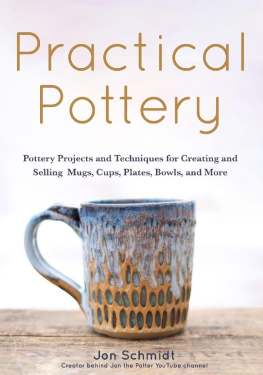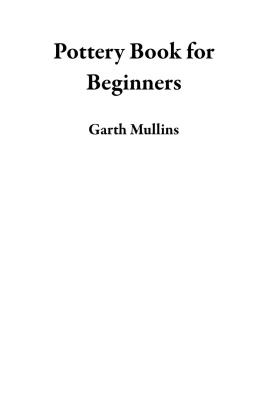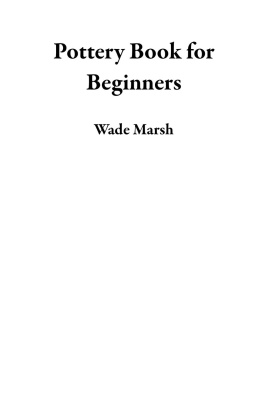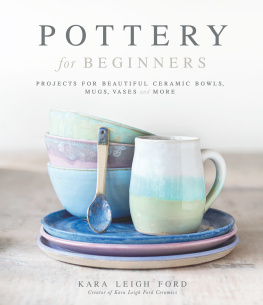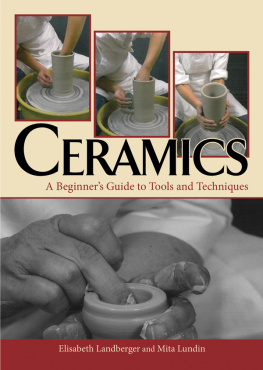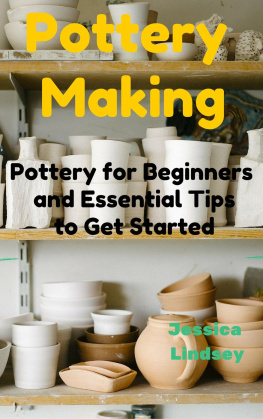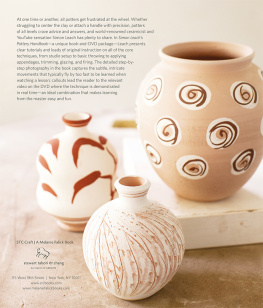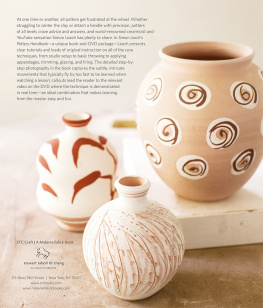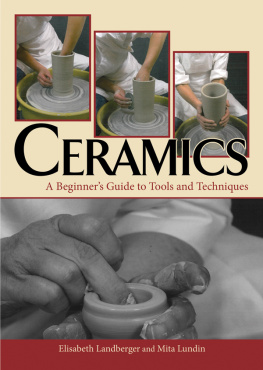CREATIVE POTTERY
Innovative Techniques & Experimental Designs
in Thrown & Handbuilt Ceramics
DEB SCHWARTZKOPF

Foreword
Ive always liked the term building pots when talking about the process of making pottery: It is very much a construction project with different components being assembled to make the whole. These components can be generated in many ways. They can be thrown on the wheel, formed or cast from molds, constructed out of slabs, or pinched out of coils. The component shapes can be developed through drawings, both by hand and digitally, and refined through making and remaking. In time, the production becomes fluid and seemingly effortless. The clay acts differently at each stage of its drying journey. A potters understanding of this, along with their sensitivity of touch, brings a unique voice to the delicate surface of a handmade pot.
Yet sometimes constructed pots feel like they are trying too hard to be cleverperhaps their presence is overshadowed by a newly discovered technique. I believe the best pots find a healthy balance, incorporating subtle innovations that do not overwhelm the true intention of the pot. The proof is in the pudding: how well does the pot fulfill the idea for which it was made?
Deb Schwartzkopf was among the first group of resident artists to work in the new David and Ann Shaner Studio at the Archie Bray Foundation when it opened in 2004. Her pots brought a different play of shape and line to the mix of work being made in the studio, and Deb brought a positive spirit of innovation to the community. It was clear that Deb knew what she wanted to be: a full-time studio artist.
Years later, her vision came into focus with the creation of Rat City Studios. Much like her pots, Deb has assembled a diverse range of interests into something dynamic with a clear intention. Making a living today as a studio potter requires an intricate weaving of many different components, each carefully considered and formed, and then sensitively joined together to make the whole thing work. As the late David Shaner once said, There is no sense making pottery unless youre willing to live for pottery. With an honest effort, the individuals interests and passions are reflected in the choices and the sensitivity with which the effort is assembled. Everyones path is different and however anyone puts it together to make their own work is fair game. Its all about finding the balance.
On one level, this book is about techniques for making pottery, about assembling parts to construct a well-balanced vessel. But by extension, it is about a spirit of entrepreneurship and the choices one makes to produce studio pottery in our modern age. All aspects of the production are important and contribute to the whole. The different choices reflect the individual and shape the aesthetic of the maker. We need all kinds of pots.
JOSH DEWEESE
Josh DeWeese , Pitcher, photo courtesy of the artist
Josh DeWeese , Ewer, photo courtesy of the artist
Introduction
Welcome! This book is for potters looking to explore and gain new skills. I encourage you to jump right in. Start thinking of cylinders and slabs as a starting placebuilding blocks that can be altered, added onto, or combined in many ways. In this book, youll find playful, technique-based projects that will hone your skills on everything from altering and attachments to molds and templates. Try creating an asymmetrical curving vase or Handbuilding a teapot spout from a soft slab. Learn how to pick and choose between wheel-throwing and Handbuilding techniques to get the outcome you want. This is your journey!
Rat City Studios, where Deb lives and works.
MY JOURNEY AS A POTTER
For as long as I can remember, I always wanted to make things to share with others. I learned to do this with food first. My grandmother showed her affection through baking cookies and coffee cake for every visit and holiday. I learned from her and my mother that there is nothing better than sharing food with people near and dear. Pottery was a next step along that path, as handmade pottery makes mealtimes even more special and heartfelt.
I took my first ceramics class in 1998 as a Running Start high school student at Highline Community College. Eventually I followed my passion and studied ceramics at The University of Alaska Anchorage (UAA). During these exciting beginning years, my professors Steve Godfrey, Robert Banker, and Pam Pemberton, and mentors Peter Brondz and Kris Bliss guided me, helping to set my foundation firmly in the world of pottery. Early on, Steve encouraged students to visit local potters. He wanted us to see firsthand what it was like to have a career as a potter. I was in awe when I visited Peters studio: the luminous timber-framed building, the secluded woodland setting, the self-serve gallery, and his thoughtful, functional work drew me in. Right then, I made it a goal to embrace this lifestyle and become a potter. I learned invaluable skills both in school and through working with local potters.
Working for potters was a crucial part of my education. In assisting with daily studio operations, I witnessed the stamina it takes to make pottery for a living, the efficiency that helps get the bills paid, and the marvelous autonomy that being a small business owner provides. It is so important that experiential learning opportunities continue to exist for emerging artists who want to pursue careers in the ceramic arts.
After graduating from UAA in 2002, I decided to focus on surface (and get a little sunshine) at San Diego State University, where I learned from Richard Burkett and Joanne Hayakawa. As a post-bac student, I tested glazes like crazy and loved it! All the potential was right in front of me. I just had to unlock it.
Kris Bliss (Mentor to Deb Schwartzkopf), Medium Flare
Peter Brondz (Mentor to Deb Schwartzkopf), Oil and Vinegar Service, photos by Deb Schwartzkopf
Pennsylvania State University accepted my application for an MFA in 2003. I had worked so hard to learn how to work with clay; now I wanted to focus on the concepts within my practice and deepen my skills. I began to blend wheel throwing and handbuilding techniques. At first these experiments created very awkward pots, but over time I found fluency. In those two years I gleaned from the thoughtful perspectives and questions of Liz Quackenbush, Chris Staley, Margaret Bohls, Nick Joerling, John Utgaard, and all the students learning with me!


